Mamba snakes have quite a frightening reputation thanks to their speedy, aggressive natures and deadly venom! Of course, the most well-known (or perhaps infamous!) type of mamba is the eerily monochromatic black mamba, but what other kinds exist? Does the black mamba have any equally deadly cousins, and if so, how many species are there? What kinds of traits do they share?

In addition to covering what exactly makes a snake a mamba and the different species of mambas, this article will also identify which one is the deadliest! Let’s take a closer look–but certainly not too close–at these fast-moving, agile, and extremely venomous snakes below.
What is a Mamba?
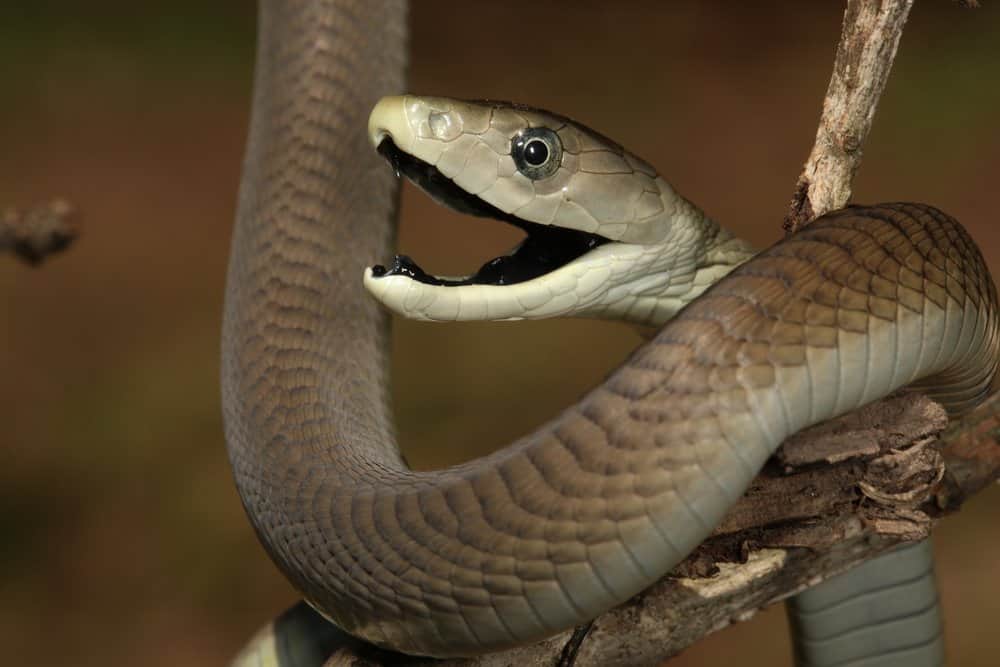
The
black mamba
is fast, aggressive, and highly venomous.
©NickEvansKZN/Shutterstock.com
To put it simply, mambas are any of the four species of snakes within the Dendroaspis genus:
- Black mamba, Dendroaspis polylepis
- Eastern green mamba, Dendroaspis angusticeps
- Western green mamba, Dendroaspis viridis
- Jameson’s mamba, Dendroaspis jamesoni
Interestingly, the Dendroaspis genus is one of the 55 total genera (consisting of around 350 total species!) within the Elapidae family. This makes mambas closely related to other elapid snakes like cobras, kraits, and taipans. The scientific term “Dendroaspis” translates to “tree asp,” a reference to the mambas’ primarily arboreal nature.
Mambas share a few key traits:
- Mambas are extremely venomous. All four species have venomous, painful, and often deadly bites. Their venom is neurotoxic and cardiotoxic, so it attacks the nervous system and the heart.
- Mambas are really fast! They’re actually some of the fastest snakes on the planet. In particular, black mambas can move as quickly as 12.5 miles per hour.
- Mambas “rear up” and display their hoods when threatened. Because they’re related to cobras, mambas actually have hoods similar to those of cobra species like the king and Indian cobras! However, mambas’ hoods are much narrower and less prominent. When threatened, mambas will also lift their bodies off the ground and “rear up” like cobras to make themselves look larger and more intimidating.
- MOST mambas are arboreal. Their long, slender yet strong bodies are well-suited to traversing and camouflaging themselves amongst tree branches and vines. The only exception is the black mamba, which is primarily terrestrial.
- Mambas are diurnal. They are active during the day and sleep at night.
- Mambas are native to Africa. All four types of mamba snakes are native to sub-Saharan Africa. The arboreal varieties live in very hot, densely forested regions. Black mambas prefer savannas and rocky outcrops.
1. The Eastern Green Mamba
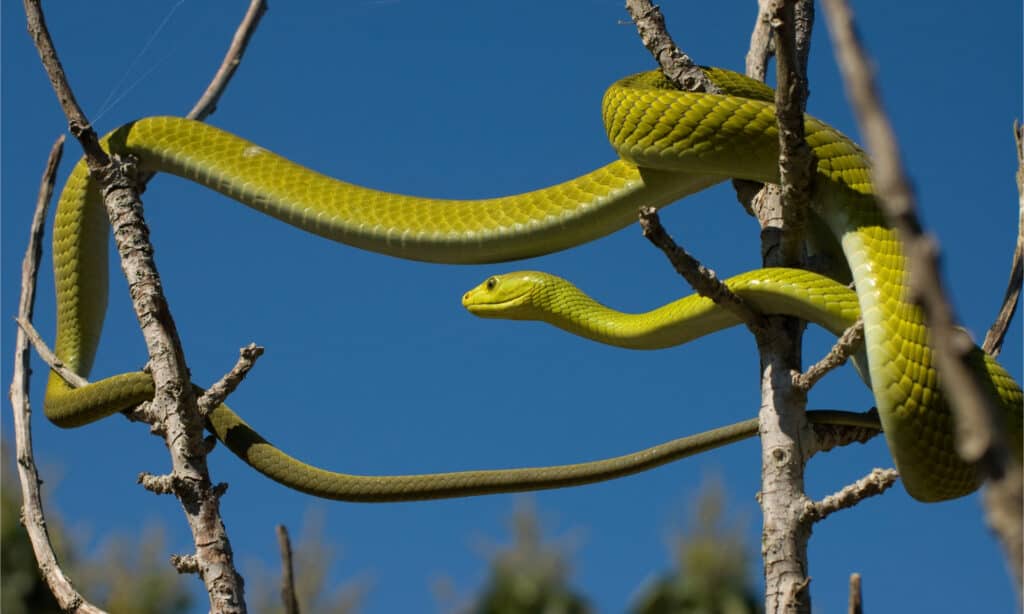
The eastern green mamba is perfectly suited to an arboreal lifestyle.
©Heiko Kiera/Shutterstock.com
Dendroaspis angusticeps, better known simply as the eastern green mamba, is one of the four mamba species. True to its name, this colorful snake is a vibrant, leaf green from snout to tail tip, and it mainly lives along Africa’s southeastern coasts.
The eastern green mamba typically reaches around 6 feet long, with males being slightly smaller than females. It has a slim build and is extremely fast-moving. This, along with its clever vine-green camouflage, allows the snake to quickly and stealthily traverse the canopies of trees in search of its bird and rodent prey.
Like the other mamba species listed here, the eastern green mamba’s bite is extremely venomous and can be fatal if untreated. Its venom is cardiotoxic and neurotoxic, meaning it can quickly shut down a bite victim’s nervous system and heart at the same time.
Fortunately, also similar to its other mamba cousins, eastern green mambas are typically shy and skittish. They generally avoid urban areas or areas where groups of humans otherwise congregate often. However, this species in particular tends to bite its victims more than once due to its speedy, nervous temperament. Each bite can deliver around 80 to 100 milligrams of venom!
2. The Western Green Mamba
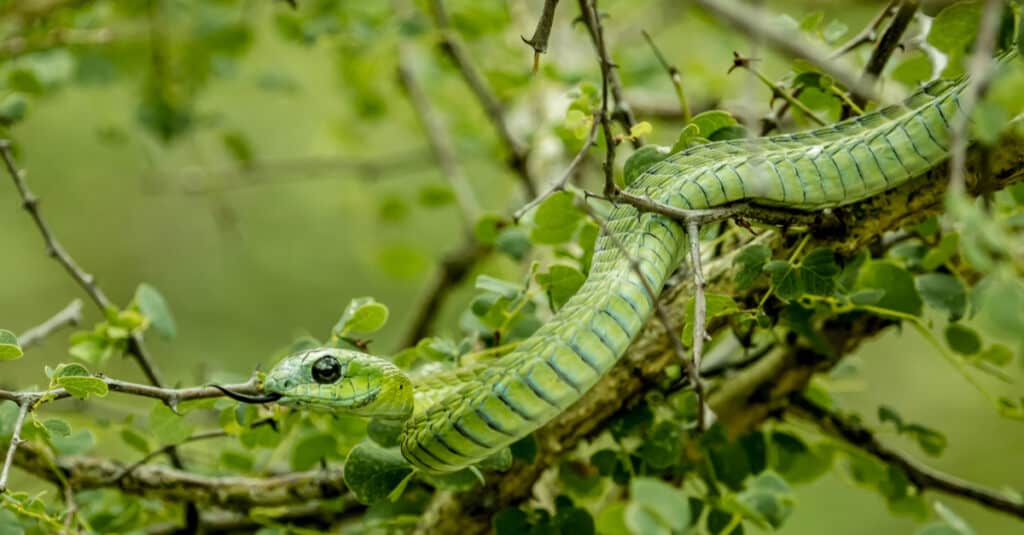
Western green mambas are highly venomous, but they aren’t particularly aggressive towards humans.
©OrodO/Shutterstock.com
Up next, we have the western green mamba, also known taxonomically as Dendroaspis viridis. As its common name suggests, the western green mamba is green in color and primarily lives along Africa’s northwestern coast. Additionally, its official Latin name, viridis, simply translates to “green.”
Although it has a slender build, the western green mamba is still a fairly substantial snake, often reaching between 5 and 8 feet in length. It’s large, heavily defined scales have thin, black outlines and range from leaf green to pale yellow. Typically, the snake’s dorsal side is more greenish in color, while its belly (ventral side) is more yellowish.
Interestingly, despite being highly venomous, this particular type of mamba rarely bites–let alone interacts with–humans. Of the four mamba species, the western green mamba is widely known as the shyest and most skittish of the bunch. Thankfully, this means they prefer to avoid urban areas where humans reside. However, if they are threatened or backed into a corner, they can still quickly become fearful and aggressive.
Western green mamba venom contains neurotoxins, cardiotoxins, and, most notably, fasciculins. Fasciculins are toxic proteins present in various snakes’ venoms, primarily mambas. These toxic proteins cause fasciculations, better known as muscle spasms, and essentially work to paralyze a bite victim’s muscles.
In short, the western green mamba is technically one of the deadlier mamba varieties. However, this species typically avoids humans and is not especially aggressive.
3. Jameson’s Mamba
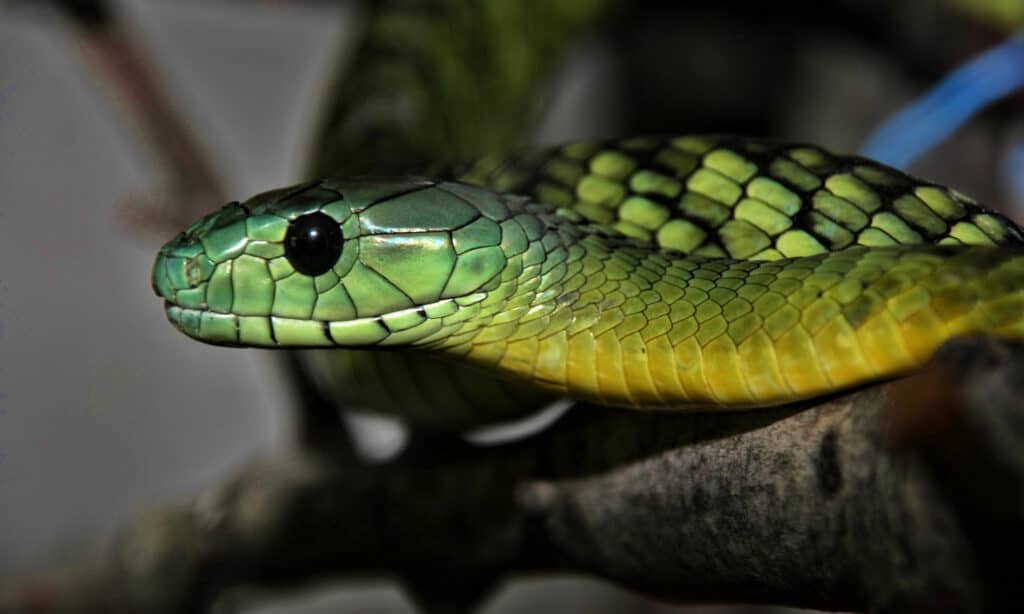
The Jameson’s mamba is the only mamba snake to have any subspecies.
©Vladislav T. Jirousek/Shutterstock.com
The Jameson’s mamba, Dendroaspis jamesoni, is perhaps the least well-known of the four mamba species. However, its visually stunning appearance, unique behavior, and deadly venom make it just as fascinating and worth understanding.
For starters, this mamba species is the only one to have any subspecies, of which there are two: Dendroaspis jamesoni kaimosae, named for western Kenya’s Kaimosi Forest where it was initially found and mainly resides, and Dendroaspis jamesoni jamesoni, which has a slightly wider geographic range and lives throughout central and northwest Africa.
Both Jameson’s mamba subspecies are highly arboreal and prefer fairly humid, densely wooded rainforests. However, they are increasingly moving toward urban areas due to habitat loss and deforestation. Of the four types of mambas, this variety is the most agile and arboreal. It spends much of its life high up in the canopies of trees.
Just like the other mambas listed here, Jameson’s mambas have fast-acting neurotoxic and cardiotoxic venom. Fasciculins are also present in the venom to paralyze the muscles of bite victims. Bites from this mamba require immediate treatment, as death can occur within hours.
4. The Black Mamba
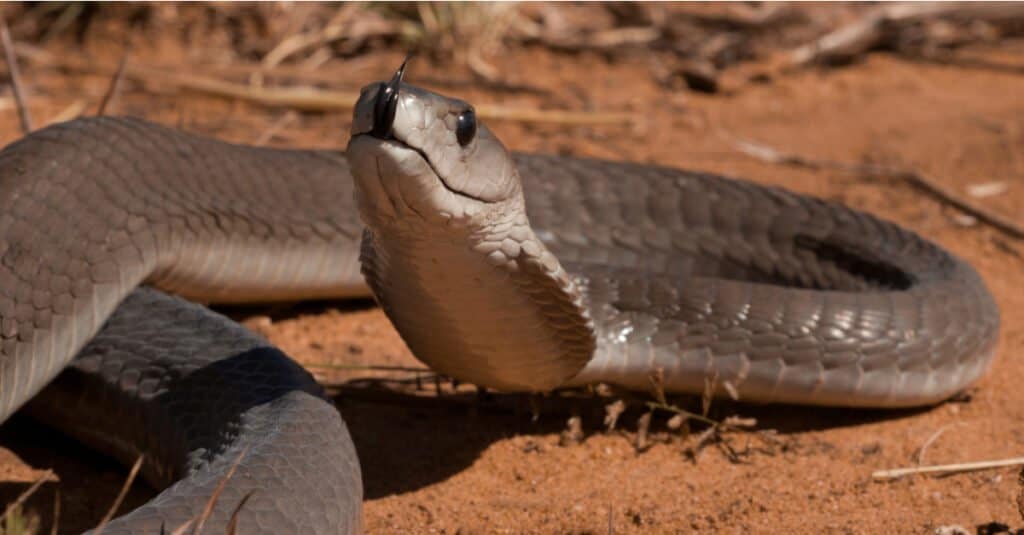
Similar to various
cobra species
, the black mamba will stretch out and display the hood around its neck when threatened.
©131346563/Shutterstock.com
Finally, we come to the most notorious mamba of all: the fearsome, dreaded black mamba. Of the four mamba species, this variety is the largest and the most venomous! It’s also the second-longest venomous snake in the world, just behind the king cobra in length.
Aside from its highly neurotoxic and cardiotoxic venom, the black mamba’s most striking trait is its spooky monochromatic appearance: smoky grey skin, eerie black eyes, and a jet-black mouth. Black mambas often open their mouths as wide as they can to display the terrifyingly large black abyss within as a threat display to ward off predators–and it’s pretty effective!
Despite having a fairly slender build, it’s still a quite large snake, ranging from 8 to 14 feet in length when fully grown. As one of the heavier mamba varieties, it prefers a much more terrestrial lifestyle closer to the ground. However, it is also an adequate climber when needed. Black mambas are also quite speedy and are capable of moving and striking at up to 10 mph.
Of course, we can’t discuss the black mamba without discussing its venom. As one of Africa’s deadliest and most venomous snakes, its bite is often fatal if not treated immediately. Its highly potent neurotoxic, cardiotoxic venom also contains fasciculins. This results in a deadly cocktail that can cause respiratory and cardiovascular failure in a healthy adult within just a few short hours.
Which Mamba Snake is the Deadliest?
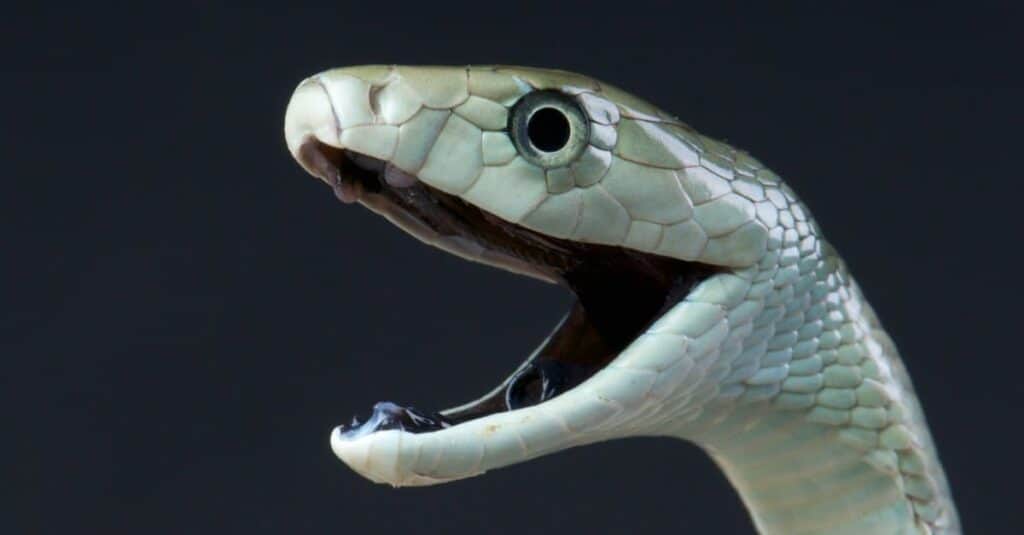
The black mamba is widely considered to be the deadliest mamba species.
©reptiles4all/Shutterstock.com
While all four mambas are certainly deadly to some extent, the black mamba definitely hasn’t gained the horrific reputation it has for no reason! There are a few reasons why the black mamba is generally considered to be the most deadly type of mamba.
As well as being the most aggressive species of the bunch, the black mamba is also very agile and able to launch its body impressively long distances when striking. What’s more, although it’s mostly terrestrial, it’s an incredibly fast-moving species both on land and in the trees.
Another factor that makes black mambas so deadly is they’re more than fast and skilled enough to bite their victims multiple times within mere seconds. Each bite can deliver up to 120 milligrams of neurotoxic, cardiotoxic venom! The venom is incredibly fast-acting, with some very dire symptoms becoming visible in as little as 10 to 15 minutes.
Finally, the black mamba is also known as the most unpredictable type of mamba, which significantly contributes to its overall deadliness. Though it is more likely to run and hide if directly threatened, it is known to sometimes strike humans with no prior warning or threat display.
To sum up: lightning-fast speed, an irritable temperament, erratic behavior, a painful bite, and potent venom all come together to create Africa’s most fearsome, deadly snake.
Summary of the 4 Types of Mambas: Is the Black Mamba the Deadliest of All?
| Rank | Type of Mamba |
|---|---|
| 1 | Eastern Green Mamba |
| 2 | Western Green Mamba |
| 3 | Jameson’s Mamba |
| 4 | Black Mamba |
The photo featured at the top of this post is © reptiles4all/Shutterstock.com
Discover the "Monster" Snake 5X Bigger than an Anaconda
Every day A-Z Animals sends out some of the most incredible facts in the world from our free newsletter. Want to discover the 10 most beautiful snakes in the world, a "snake island" where you're never more than 3 feet from danger, or a "monster" snake 5X larger than an anaconda? Then sign up right now and you'll start receiving our daily newsletter absolutely free.
Thank you for reading! Have some feedback for us? Contact the AZ Animals editorial team.







